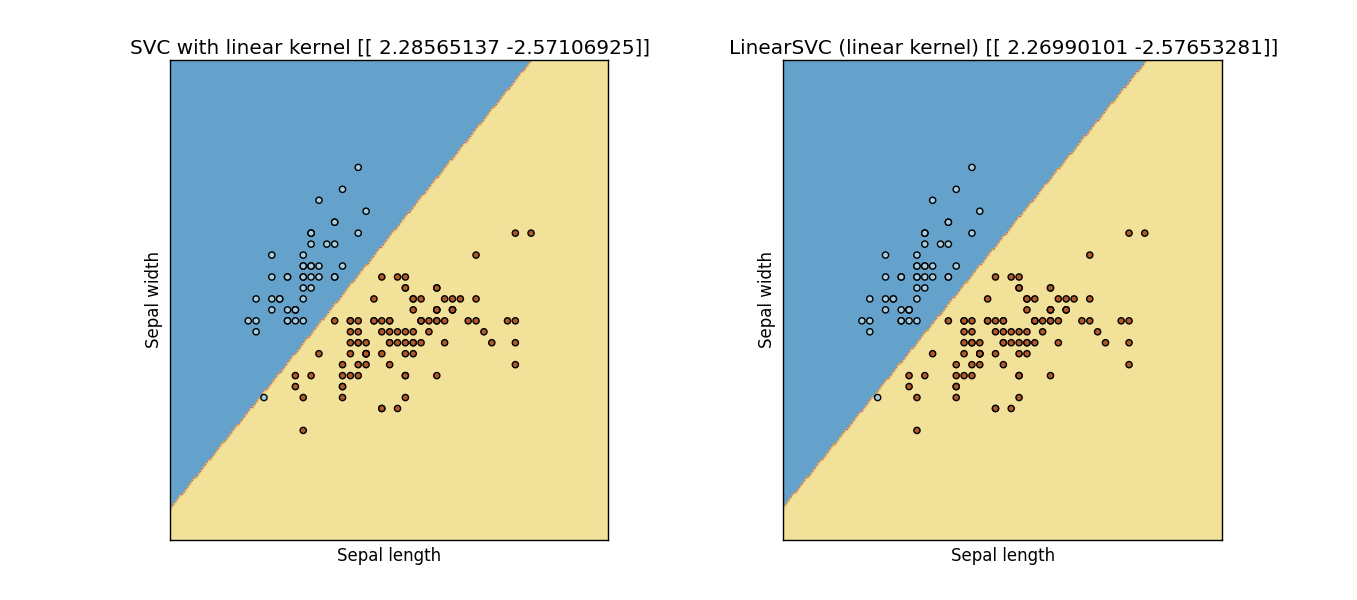I read this thread about the difference between SVC() and LinearSVC() in scikit-learn.
Now I have a data set of binary classification problem(For such a problem, the one-to-one/one-to-rest strategy difference between both functions could be ignore.)
I want to try under what parameters would these 2 functions give me the same result. First of all, of course, we should set kernel='linear' for SVC()
However, I just could not get the same result from both functions. I could not find the answer from the documents, could anybody help me to find the equivalent parameter set I am looking for?
Updated: I modified the following code from an example of the scikit-learn website, and apparently they are not the same:
import numpy as np
import matplotlib.pyplot as plt
from sklearn import svm, datasets
# import some data to play with
iris = datasets.load_iris()
X = iris.data[:, :2] # we only take the first two features. We could
# avoid this ugly slicing by using a two-dim dataset
y = iris.target
for i in range(len(y)):
if (y[i]==2):
y[i] = 1
h = .02 # step size in the mesh
# we create an instance of SVM and fit out data. We do not scale our
# data since we want to plot the support vectors
C = 1.0 # SVM regularization parameter
svc = svm.SVC(kernel='linear', C=C).fit(X, y)
lin_svc = svm.LinearSVC(C=C, dual = True, loss = 'hinge').fit(X, y)
# create a mesh to plot in
x_min, x_max = X[:, 0].min() - 1, X[:, 0].max() + 1
y_min, y_max = X[:, 1].min() - 1, X[:, 1].max() + 1
xx, yy = np.meshgrid(np.arange(x_min, x_max, h),
np.arange(y_min, y_max, h))
# title for the plots
titles = ['SVC with linear kernel',
'LinearSVC (linear kernel)']
for i, clf in enumerate((svc, lin_svc)):
# Plot the decision boundary. For that, we will assign a color to each
# point in the mesh [x_min, m_max]x[y_min, y_max].
plt.subplot(1, 2, i + 1)
plt.subplots_adjust(wspace=0.4, hspace=0.4)
Z = clf.predict(np.c_[xx.ravel(), yy.ravel()])
# Put the result into a color plot
Z = Z.reshape(xx.shape)
plt.contourf(xx, yy, Z, cmap=plt.cm.Paired, alpha=0.8)
# Plot also the training points
plt.scatter(X[:, 0], X[:, 1], c=y, cmap=plt.cm.Paired)
plt.xlabel('Sepal length')
plt.ylabel('Sepal width')
plt.xlim(xx.min(), xx.max())
plt.ylim(yy.min(), yy.max())
plt.xticks(())
plt.yticks(())
plt.title(titles[i])
plt.show()
Result: Output Figure from previous code


loss = 'hinge'parameter, but they still don't give me the same(or even close) results.... – Colombes